Selective pressures for and against genetic instability in cancer: a time-dependent problem
- PMID: 17580291
- PMCID: PMC2605501
- DOI: 10.1098/rsif.2007.1054
Selective pressures for and against genetic instability in cancer: a time-dependent problem
Abstract
Genetic instability in cancer is a two-edge sword. It can both increase the rate of cancer progression (by increasing the probability of cancerous mutations) and decrease the rate of cancer growth (by imposing a large death toll on dividing cells). Two of the many selective pressures acting upon a tumour, the need for variability and the need to minimize deleterious mutations, affect the tumour's 'choice' of a stable or unstable 'strategy'. As cancer progresses, the balance of the two pressures will change. In this paper, we examine how the optimal strategy of cancerous cells is shaped by the changing selective pressures. We consider the two most common patterns in multistage carcinogenesis: the activation of an oncogene (a one-step process) and an inactivation of a tumour-suppressor gene (a two-step process). For these, we formulate an optimal control problem for the mutation rate in cancer cells. We then develop a method to find optimal time-dependent strategies. It turns out that for a wide range of parameters, the most successful strategy is to start with a high rate of mutations and then switch to stability. This agrees with the growing biological evidence that genetic instability, prevalent in early cancers, turns into stability later on in the progression. We also identify parameter regimes where it is advantageous to keep stable (or unstable) constantly throughout the growth.
Figures


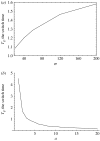
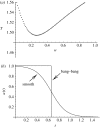
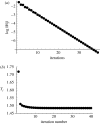


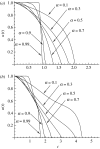

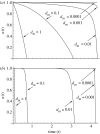


Similar articles
-
Fastest time to cancer by loss of tumor suppressor genes.Bull Math Biol. 2014 Nov;76(11):2737-84. doi: 10.1007/s11538-014-0027-7. Epub 2014 Oct 23. Bull Math Biol. 2014. PMID: 25338553 Free PMC article.
-
Evolution of genetic instability in heterogeneous tumors.J Theor Biol. 2016 May 7;396:1-12. doi: 10.1016/j.jtbi.2015.11.028. Epub 2016 Jan 27. J Theor Biol. 2016. PMID: 26826489 Free PMC article.
-
The null oncogene hypothesis and protection from cancer.J Med Genet. 2002 Jan;39(1):12-4. doi: 10.1136/jmg.39.1.12. J Med Genet. 2002. PMID: 11826018 Free PMC article.
-
Prognostic significance of oncogenes and tumor suppressor genes in human malignancy.Stem Cells. 1993 May;11(3):194-8. doi: 10.1002/stem.5530110305. Stem Cells. 1993. PMID: 8318905 Review.
-
Can chromosomal instability initiate tumorigenesis?Semin Cancer Biol. 2005 Feb;15(1):43-9. doi: 10.1016/j.semcancer.2004.09.007. Semin Cancer Biol. 2005. PMID: 15613287 Review.
Cited by
-
Optimality in the development of intestinal crypts.Cell. 2012 Feb 3;148(3):608-19. doi: 10.1016/j.cell.2011.12.025. Cell. 2012. PMID: 22304925 Free PMC article.
-
Adaptive dynamics of unstable cancer populations: The canonical equation.Evol Appl. 2018 Apr 17;11(8):1283-1292. doi: 10.1111/eva.12625. eCollection 2018 Sep. Evol Appl. 2018. PMID: 30151040 Free PMC article.
-
Fastest time to cancer by loss of tumor suppressor genes.Bull Math Biol. 2014 Nov;76(11):2737-84. doi: 10.1007/s11538-014-0027-7. Epub 2014 Oct 23. Bull Math Biol. 2014. PMID: 25338553 Free PMC article.
-
Modelling the evolution of genetic instability during tumour progression.Evol Appl. 2013 Jan;6(1):20-33. doi: 10.1111/eva.12024. Epub 2012 Nov 26. Evol Appl. 2013. PMID: 23396531 Free PMC article.
-
Hyperbolastic modeling of tumor growth with a combined treatment of iodoacetate and dimethylsulphoxide.BMC Cancer. 2010 Sep 23;10:509. doi: 10.1186/1471-2407-10-509. BMC Cancer. 2010. PMID: 20863400 Free PMC article.
References
-
- ADIFOR 1994 ADIFOR 2.0: automatic differentiation of Fortran A collaborative project between the Mathematics and Computer Science Division at Argonne National Laboratory and the Center for Research on Parallel Computation at Rice University, http://www-unix.mcs.anl.gov/autodiff/ADIFOR/.
Publication types
MeSH terms
Grants and funding
LinkOut - more resources
Full Text Sources
Research Materials

